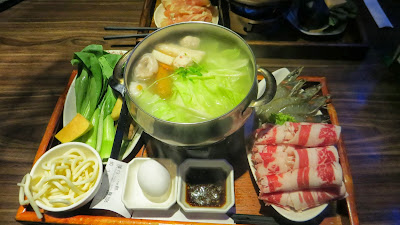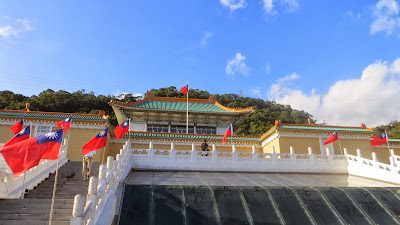Mt. Kinabalu is the largest mountain in Borneo, in Malaysia and – as a matter of fact – in
Southeast Asia between the peaks of the Himalaya
and the mountain ranges of New Guinea. At 4,095m, it is higher than any
peak in alpine Austria or Spain’s tallest
mountain El Teide and ranked as the 20th most prominent peak in the
world as it is not part of a larger mountain range. Have Ana and Simon become
serious mountaineers or how did they make it?
 |
| First view of Mt. Kinabalu from the bus getting the group to the National Park |
 |
| The top of Mt. Kinabalu |
 |
| Ana and Simon being very optimistic before starting their ascent |
To tell you how this part of their Asian adventure
developed, you need to know that – despite its prominence – Mt. Kinabalu
is also considered as one of the most accessible peaks which makes it an
attractive destination for people who think they can make it there - basically, no mountaineering skills are required. Ana had
heard great things about Borneo and Mt.
Kinabalu from her
colleagues and Simon learned about tracks to the mountain when fellow INSEAD
students went there earlier in 2013 and were deeply impressed. They assembled a
team of six (including them) which truly reflected the diverse background of
people that they have met over the year in Singapore: two British, one
British-Tunisian, one French and the German / Spanish team would climb the
mountain on a long weekend in November.
 |
| International mountain expedition ready to go |
Ana, Simon and the group flew from Singapore to
Kota Kinabalu (or KK), a provincial capital in the North of Malaysian Borneo on
Friday night. They spent the night at an affordable hotel and were picked up by
their tour operator to be driven to the Mt. Kinabalu
National Park. They met
their tour guide, could look at the challenge ahead and were equipped with some
bagged lunch. Around 9AM, off they went. The ascent on the first day is about
6km long and goes from 1,866m to 3,270m – an average of 23% ascending slope.
The program for the second day would then see another 2.7km to reach the Low’s
Peak (named after the first person to explore the top part of Mt. Kinabalu)
at 4,095m – another 30% slope.
 |
| Yes, it was quite steep |
 |
| Going uphill through dense vegetation |
The ascent on the first day passes quite dense vegetation,
even in areas that are higher than Germany tallest mountain that
always has some ice on its top. The group of six managed thinner air and
literally walking through clouds. It was tough going up but there were shelters
along the way that provided space for short rests and eventually, they managed
quite well and reached their hut in the afternoon. The accommodation was basic
but fulfilled the needs. They knew they had to gather their strengths so after
re-packing, some safety instructions and a well-deserved dinner, they hit the
beds around 8PM as they knew the night would end early.
 |
| A much needed break on the way |
 |
| The stop for the night |
The second day started at 2:00 AM! As around 180 climbers
would sleep in different huts around the same height, our guide decided to
leave at 3AM to ensure that there would be less “traffic jams”. In pitchblack
darkness, they were all equipped with head torches and started the ascent. The
steps were larger, the trail was tougher – despite the fact that Mt. Kinabalu is well-accessible, getting to the summit does not come easy. At places, they
could see a procession of lights above and below them, passing quite many
fellow mountaineers and the group was well in time to reach the summit for
sunrise. Suddenly, the vegetation stopped and everyone needed to walk over
naked granite rocks – incl. some parts where one needed to pull oneself up with
the help of a rope. Slowly, some structures became visible around the group as
dawn was breaking. The last 50
meters could be climbed without the head torches and the
group just made it in time for the sunrise. Let the pictures speak.
 |
| Parts of the "procession" coming up the mountain |
 |
| First glimpse of light on the horizon (see the lights of fellow climbers on the lower right corner) |
 |
| The sun is coming... |
 |
| First view of the neighboring peak |
Despite the fact that it was only 3 degrees, no one was cold.
Going up the mountain created so much heat that Ana and Simon were fine with
just a t-shirt and a rain jacket (that they didn’t need – yet) and after the
sun had risen, it still radiated enough heat for them not to be cold. After 20
minutes on the summit, they started their descent but the adventure part of the
trip was not over still.
 |
| Sunrise behind the British-Tunisian, British, German and Spanish parts of the expedition |
 |
| And there it is. Very rewarding sight! |
 |
| The group of six on top! |
 |
| Mt. Kinabalu literally cast quite an impressive shadow at sunrise |
The tour that they had booked (much in advance) included a
“Via Ferrata” which literally means “iron street” and basically is a set of
steel cables, steel steps and handles in the mountain. This way, it is possible
for climbers to safely explore more extreme parts of the mountain and Ana and
Simon did exactly that, together with Julien (the French) and Ed (British –
know from other blog entries). The operators were super professional and the
level of safety was higher than in Europe
(according to people who had done it before – it was the first time for Ana and
Simon). The experience there was quite different – thrilling, exhausting, scary
at times but totally worth it.
 |
| Simon coming down from the top |
 |
| Ready for the Via Ferrata |
 |
| Down they go |
 |
| Clouds were coming in... |
 |
| Crossing a "monkey bridge" |
 |
| Almost done |
They reached the hut around 11AM, had a second breakfast and
prepared for the way down. This was actually the tricky part as the strain on
the legs tends to be greater when going downhill and now, they had to go all
the way down where they had the full day to go up on Saturday – after having
climbed the peak, done the Via Ferrata and descended to the hut. Moreover,
tropical rain started (it was actually forecasted to rain heavily during the
ascent at night so they were quite lucky that the rain was delayed) and really
taught them a lesson why the vegetation around Mt. Kinabalu
is called “rain forest”. The group was getting tired and at the same time
amazed what they had climbed up on the first day. After all, they managed to
reach the station that they had departed from 30 hours earlier around 5PM and
then realized that they had been exercising for 14 hours (minus one hour
breakfast break). What a day.
 |
| Wet and exhausted - but happy! |
 |
| Well-deserved (and pretty) set of diplomas for Ana and Simon's accomplishment |
The sense of achievement cannot be underestimated. Ana and
Simon felt that they had completed a Marathon
and actually had the benefit of seeing an awesome sunrise while doing this.
They were back in KK at night, had a well-deserved dinner and enjoyed the best
shower in many years as well as a very comfortable night of sleep. The sore
muscles that they had to fight the next few days were well worth the
experience. No pain, no gain!
 |
| True story |














































